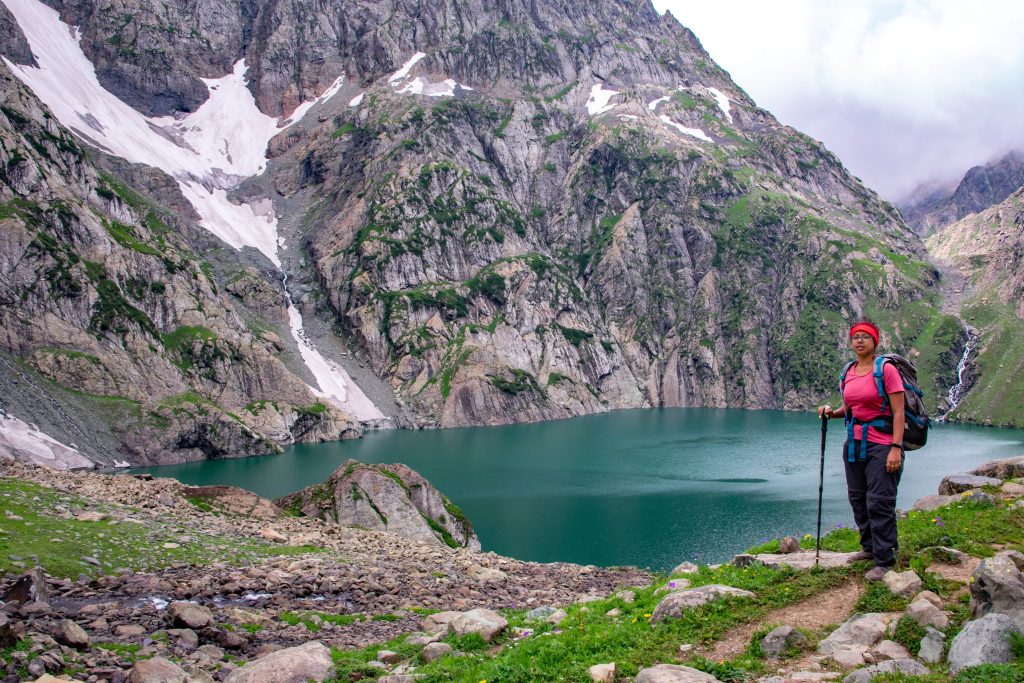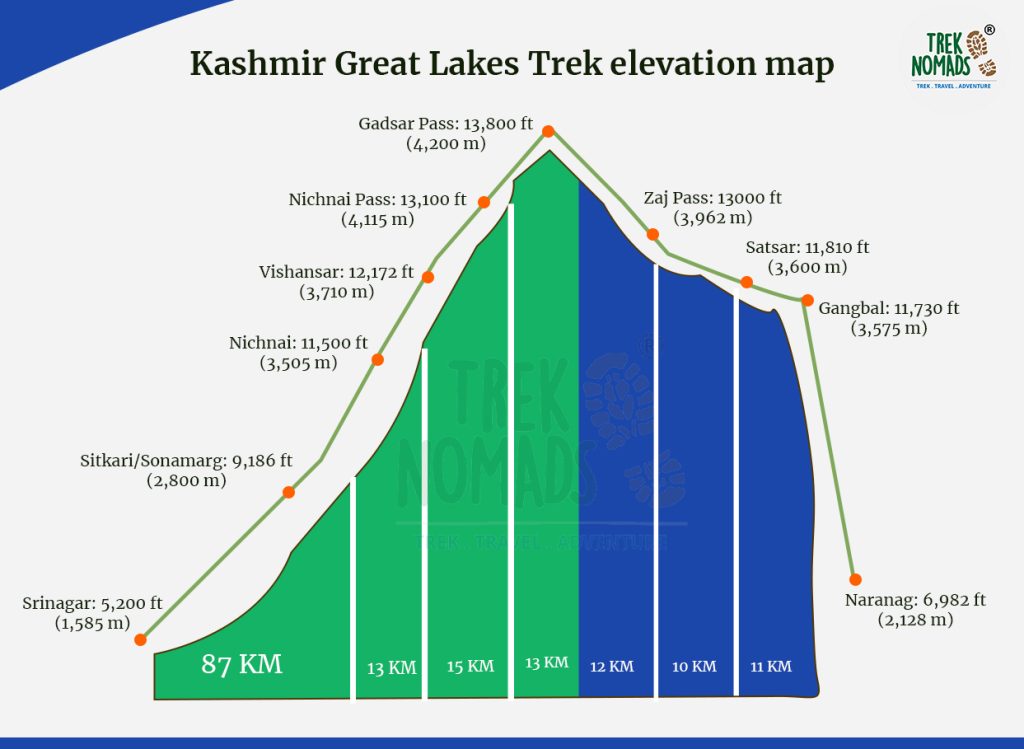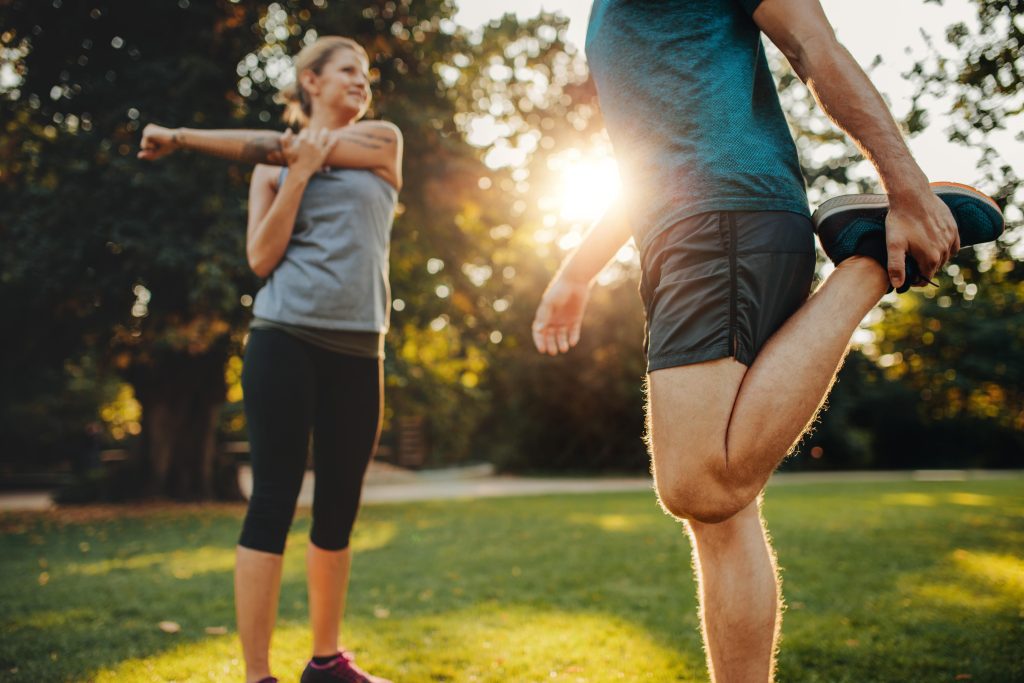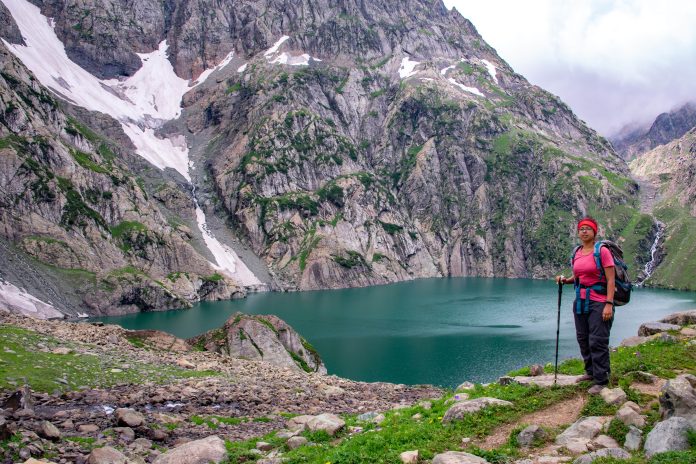Kashmir great lakes trek is a beautiful opportunity for trek lovers. But wait, this trek is not a simple long walking journey. Indeed, trekking involves walking, but it is about something other than a regular hike. It involves climbing, sometimes even hopping and jumping, which requires good physical strength. The steeper ascents and descents need good balancing between your upper, lower, and core body.
If you are a beginner, this trek might get challenging for you. An experienced trekker must also involve a fitness regime at least 1-3 months before the trek. If you have an intermediate fitness level, we suggest you practise a proper workout schedule 3-5 months before the trek.

Difficulties of the KGL Trek explained:
The KGL trek has many steep ascents and descents which tests your mental and physical strength. The difficulties at KGL keep on increasing with each passing day because of the increasing altitude. As you progress towards Gadsar Pass (4,200 m/13,800 ft) which is the highest point of the trek, the altitudes of the consecutive campsites keep increasing. (Sitkari- 2,800 m/9,186 ft | Nichnai- 3,505 m/11,500 ft | Vishansar- 3,710 m/12,172 ft)

The Gadsar pass has steeper sections that will test your physical endurance. This requires mental and physical toughness to cross those steep ascents and descents. While the trek to Gadsar pass is the most difficult part of the trek, the tough terrain towards Nichanai should also be taken into consideration.
The trek trail is pretty tough so we recommend you to carefully listen to the instructions given by your trek leader and follow them. Because of the high altitudes, you might also experience symptoms of AMS (Acute Mountain Sickness). You must be prepared both mentally and physically to cross such challenging trails. Your core body, legs and shoulders need to be strong. So, work on these areas while preparing for the trek.
Getting fit for Kashmir Great Lakes Trek- Reasons for being physically fit for the trek
The tiring walks, steep ascents, and descents are just some reasons to be physically fit for the trek. Certain other factors might require you to have a healthy body. A few of them are given below.
- As you reach higher altitudes of 13,000 ft at the Gadsar pass, the air becomes thin, and the effective oxygen level in the air is just 12.7%. At this point, trekking can get challenging. At Gadsar pass, you have to trek at 50-60 degrees inclination at low oxygen levels, which means a 1.5 to 2 times increase in the climbing effort. Thus, it would help if you practised aerobic fitness to be ready to trek in such conditions.
- Walking with a backpack on, no matter how light weight it is, is not easy. It requires muscular strength and endurance. A fitness regime will help you bear the backpack’s weight while trekking.
- Walking back or descending can be more complicated than climbing up. Balancing is the key while walking up and down the trail. Exercises that promote balancing can do the job.
- Lack of preparation might leave you exhausted, and you might even have to leave the trek mid way. Good physical strength helps you complete the trek efficiently and enjoy it to its best.

What should be your fitness regime?
The above points might have given you a rough idea of the areas you must work on. You might now be wondering when and how to start. Our fitness experts believe in beginning the workout at least three months before the trek. The exercises that should be practised to improve your physical strength and endurance are given below:
Cardiovascular endurance:
As mentioned earlier, Kashmir great lakes trek is a physically challenging trek. It requires a lot of physical strength and endurance. Indulging in aerobics can help you a great deal in improving your cardiovascular endurance. It helps your lungs and heart perform better, and improves blood circulation.
Refrain from overstraining yourself by practising too many hard-core exercises for long durations. If you are a beginner, start with 30 minutes on the first day. Then gradually increase the time. A few of the activities below might help improve your cardiovascular endurance-
- Swimming
- Walking
- Running
- Aerobics
- Jogging
- Cycling
These exercises are extremely beneficial. These are simple activities that do not require any gym equipment. Practising these exercises will help you a lot during the most challenging parts of the trek. You can do these exercises in combinations. For example, walk+climb one day and walk+run the next. But remember, you are preparing for a trek, so walking should be part of every exercise routine.



Stretching and Strengthening
Imagine yourself in a situation where you will have to climb a long ascent. Will you be able to do it if you haven’t been working out regularly? Perhaps not! Because climbing the steep accents takes a toll on your calves and hamstring muscles. Working out regularly will help you improve upper, lower, and core body coordination which are crucial while you are on tricky terrain. Leg strengthening exercises help support your body well by reducing the risk of falling by promoting flexibility and mobility. You can opt for these exercises to strengthen your lower body.
- Squats– Squats are very effective in strengthening your lower body muscles. They work on your thigh and knees, making them fit for the trek. You can start with as low as five reps and increase it to 15 repetitions in 1 set.
- Lunges- This helps improve the coordination between the knee and the muscles surrounding the area. You can start with five steps to and fro initially and make it up to 20 as you reach closer to your trekking date.
- Planks– Planks help in strengthening your core strength and improves overall muscle strength. If you are a beginner, try to hold on to a plank for at least 15 seconds with three reps. Try to hold on to a plank for a minimum of 30 seconds.
- Hip hinges– A perfect exercise for hip mobility and strengthening. You will have to walk consecutively for many hours at a stretch. Thus, improving the hip’s mobility is essential. The hip hinge does wonders for it. You can start with 10 reps with each for each side.
- Gym and strength training- Strength training in the gym can also protect your joints from injury. Building muscle also can contribute to better balance and may reduce your risk of falling while trekking.
- Yoga and breathing exercises- This helps you improve your breathing patterns and improves your focus and concentration. Yoga can also help in improving mindfulness.
- Proper diet, sleep and overall wellness- Maintaining healthy eating habits can strengthen our immune system, stabilize our mood, and improve medical conditions like high blood pressure, cholesterol and diabetes.

To sum up
We suggest beginning at least three months before the trek to get the desired results. Also, remember to warm up before you start these exercises, as this will reduce muscle cramps. Doing simple stretches will help. Running and cycling will do wonders for your body. So, do include running and cycling in your exercise routine. Do not overstrain your body; take breaks and only do as much as your body can tolerate. We suggest taking two days off a week from your exercise routine to relax and calm your body.
Our client’s satisfaction is always our priority. And thus, we strive to give our trekkers a hassle-free, safe and memorable trek. Therefore, we come up with every bit of information through our blogs. So, stay tuned with us for more such blogs!
We hope this blog helps you get fit for the trek—All the best. If you still have any questions, you know where to reach us!
Some FAQs
1) I have an old injury; will I be able to do the KGL trek?
It depends on the type and seriousness of your injury. But if you have a serious injury, going on a trek might not be advisable for you. If your injury is not that serious, you can join the trek. Still, we suggest you take advice from your physician before you register with us on the KGL trek.
2) I am a marathon runner, do I need to train for the KGL trek?
Marathon runners don’t need separate training as such when it comes to trekking. Although, we do suggest indulging in exercises such as staircase cardio, elliptical workouts, and training on inclined treadmill. These exercises will give you practice to trek hassle-free on tough terrains and areas that have a high inclination.
3) I am a fat/obese person, will I be able to do the KGL trek?
Being obese should not stop you from doing the KGL trek. However, you will have to work on your stamina and fitness for 5 to 6 months before the trek. You can find a detailed guide on how to get fit for a Himalayan trek here. Still, we suggest you take advice from your physician before you register with us on the KGL trek.
4) I have thyroid disease. Will I be able to do the KGL trek? What medicines should I carry for the trek?
Having thyroid disease will not be a problem for your trek. However, fitness and health should be worked upon. Your strength, fitness and overall health is extremely essential. Thus, we recommend starting workout and exercises 3 to 4 months before the trek. As far as the medicines are concerned, please consult your physician before signing up for the trek. You need to be careful on your diet – before and during the trek.
5) How should one train for the Kashmir Great lakes trek? What should the fitness regime look like for kids and elders?
There is no need to devise separate fitness regimes for youngsters and elders. In this blog, we have suggested fitness workouts catering to all age groups. Some of these exercises require minimal to zero gear and workout equipment. Some of these workouts can even be done from the comfort of your home! Still, we suggest you take advice from your physician before you register with us on the KGL trek.
Read more:
How difficult is the Kashmir great lakes trek?
Top 6 reasons to take the Kashmir great lakes trek
Kashmir Great Lakes Trek PhotoBlog- A Visual Journey of Paradise on Earth!
